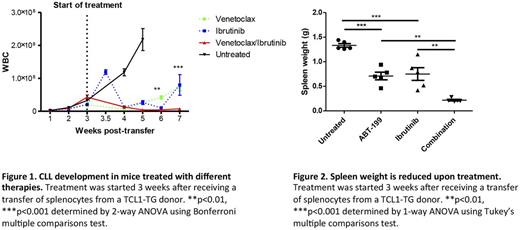Abstract
Introduction
Targeted therapy with the BTK inhibitor ibrutinib or the BH3-mimetic venetoclax has revolutionized the treatment of chronic lymphocytic leukemia (CLL). These inhibitors have a distinct mechanism of action: ibrutinib impacts BCR signaling through BTK inhibition, resulting in displacement of CLL cells from the protective lymph node environment and inhibition of proliferation whereas venetoclax directly kills CLL cells directly by inhibiting anti-apoptotic BCL-2.
While both ibrutinib and venetoclax are effective treatments for CLL as single agents, it may be beneficial to combine these treatments. There are indications that cell killing by venetoclax may not be as effective in the lymph node micro-environment due to local upregulation of BCL-XL and MCL-1 [Thijssen et al. Haematologica 2015]. Ibrutinib displaces CLL cells to the blood but does not kill them. Neither agent is curative and both are taken until resistance/relapse occurs, or until treatment is interrupted due to toxicities. Although clinical trials combining these 2 agents are currently underway, their synergistic effects are still largely hypothetical. Therefore we sought to investigate the merits of combining venetoclax with ibrutinib in the murine TCL1 transgenic model for CLL.
Methods
In the present study, immune competent C57BL/6J mice received an adoptive transfer (AT) of TCL1 splenocytes, obtained from full leukemic TCL1 transgenic mice with the same background. Three weeks after AT, when CD5/CD19% reached >90% of all B cells, mice were treated for 4 weeks with venetoclax, ibrutinib or a combination of ibrutinib and venetoclax. Ibrutinib was provided in the drinking water at a concentration of 0.16 mg/ml. Venetoclax was administered daily intra-gastric, at a dose of 100 mg/kg. CLL development was followed by flow cytometry measurements in the peripheral blood.
Results
Within the first 5 days of treatment, mice receiving ibrutinib single agent showed a rapid transient lymphocytosis (mean WBC numbers at start of treatment: 2.03*107/mL, peak mean at day 2 of treatment: 1.2*108/mL), followed by a reduction in white blood cell (WBC) numbers. Control mice experienced a rapid progression of disease, reaching a mean WBC count of 2.18*108/mL when they had to be sacrificed due to overt leukemia, 8 weeks following AT. Venetoclax and the combination treatment resulted in rapid reductions in WBC count (Figure 1). The maximum drop of WBC counts in the 3 treatment arms as compared to baseline were as follows: ibrutinib 50% at week 6, venetoclax 70% at week 4, combination: 91% at week 5, p<0.001). The mice receiving either monotherapy showed signs of relapse after 4 weeks of treatment, which was manifested by an increase in WBC counts, whereas the combination treatment did not relapse in this timeframe.
Spleen sizes of all mice at end of treatment were compared with control mice at week 5. Spleen sizes were significantly reduced in both monotherapies (% reduction: ibrutinib 47%, venetoclax 44%) and even further reduced in mice that received combination therapy (% reduction: 84%) (Figure 2). Untreated mice displayed a disturbed splenic architecture with massively enlarged marginal zones and a loss of demarcation between B and T cells, which was partially restored only in combination treatment.
The percentage of infiltrating CLL cells in the spleen was not significantly altered in the monotherapies (67% and 66% of ibrutinib and venetoclax respectively), but was significantly lower in combination treated mice (45%, p<0.001). Number of proliferating splenocytes was only reduced in mice treated with ibrutinib (28%), while cleaved caspase-3 positive B lymphocytes levels, a marker for apoptosis, was only increased in mice treated with venetoclax.
Ongoing experiments are aimed at determining levels of BCL-2 and BH3-only members, and functionality of BCR signaling in correlation with the observed effects. Furthermore, we are currently confirming whether the combination results in sustained response compared to the single treatments.
Conclusions
In conclusion, these first data from the TCL1 CLL model support the combination treatment of venetoclax and ibrutinib. Even in this short treatment timeframe, there is a more durable response with the combination treatment, which may be due to the elimination of reservoirs of CLL cells where resistance to single agent treatment can develop.
Slinger: Johnson & Johnson: Research Funding; Abbvie: Research Funding. Balasubramanian: Janssen Research & Development: Employment, Equity Ownership. Eldering: Roche: Research Funding; Gilead: Research Funding; Celgene: Research Funding. Kater: Johnson & Johnson: Research Funding; Abbvie: Research Funding; Celgene: Consultancy, Research Funding.
Author notes
Asterisk with author names denotes non-ASH members.


